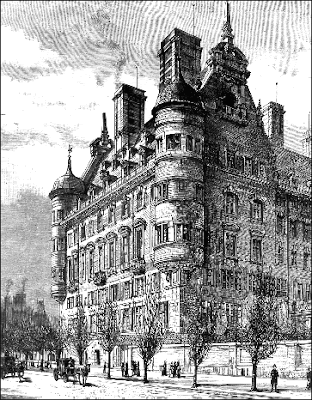Scotland Yard is the London Police elite investigation agency mentioned in Sherlock Holmes and other stories. But what is it really, and why is it called so?
It's simply the nickname given to the Metropolitan Police Service of London. The name derives from the location the Metropolitan Police headquarters moved into in 1875, 4 Whitehall Place, which had a rear entrance on a street called Great Scotland Yard. The Scotland Yard entrance became the public entrance to the police station. Over time, the street and the Metropolitan Police became synonymous. Although the Metropolitan Police moved away from Scotland Yard in 1890, the name New Scotland Yard was adopted for the new headquarters at the Norman Shaw Building.
Before 1829, law enforcement had been lacking in organisation. As London expanded during the 18th and 19th centuries the issue of maintaining law and order had become a matter of public concern. In 1749 author Henry Fielding founded London's first professional police force, known by the public as the Bow Street Runners. Originally they were just six. They did not patrol, but served writs and arrested offenders on the authority of the magistrates. Later they expanded and added a Horse Patrol.
On 29th September 1829, Sir Robert Peel formed the Metropolitan Police Force. There was some initial resistance by the public, but on the whole the experiment was successful, and in 1836 it absorbed the Bow Street Horse Patrol, then in 1838 the Marine Police and Bow Street Runners.
Interestingly, in 1839 an act was passed forming a separate independent police body, the City of London Police. The "Met", as the Metropolitan Police Service was commonly known, was responsible for law enforcement within Greater London, excluding the square mile of the City of London, which was covered by the City of London Police.
The Met's Detective Department was formed in 1842, and plain clothes officers started to be used frequently in 1846. 1858 saw the first acquisition of a horse drawn Police van for conveying prisoners. The vans came to be known as 'Black Marias'.
In 1860 the Police began the occasional use of hand ambulances for injured, sick or drunk people. Accommodation or 'ambulance sheds' were later provided in police station yards. A year later the Metropolitan Police started acting as firemen.
 |
| 1875 The Metropolitan Police moves to new headquarters on Great Scotland Yard |
Drunkenness was a problem in the force, and in 1863 215 officers were dismissed for this reason. The 1877 Trial of the Detectives or Turf Fraud Scandal exposed corruption within the Force. Two detectives were found to be in the pay of a criminal. They alerted him whenever Scotland Yard was going to arrest him. This resulted in the 1878 reorganisation of the Detective Department into the CID (Criminal Investigations Department).
Initial rules for dealing with murder cases were released in 1879. They stated "the body must not be moved, nor anything about it or in the room or place interfered with, and the public must be excluded.."
The Convict Supervision Office which provided assistance and helped control convicts discharged upon license was formed in 1880. In 1882 the Police Fire Brigade has its busiest year since formation with 6 major fires.
The Special Irish Branch was formed in March 1883, to combat the threat of Irish terrorism. The Fenians (Irish Nationalists) exploded a bomb at Scotland Yard in 1884, and the following year they bombed the Tower of London and Houses of Parliament. The "Irish" label was dropped in 1888 as the department's remit was extended to cover other threats. They became known simply as Special Branch.
In 1888 Jack the Ripper started murdering women in the Whitechapel area, and Scotland Yard were called to investigate.
 |
| 1890 New Scotland Yard headquarters at the Norman Shaw Building |
By 1892 dismissals and rank and pay reductions were common. The case of Pc379A Best illustrates how the Metropolitan Police attempted to keep its men in order. He was "in possession of a tea-can, the property of another constable, obliterating the owners number, substituting his own name and number, telling a deliberate falsehood in connection therewith; and considered unfit for the police force." PC Best resigned on 21 July. In 1893 PC George Cooke, a serving officer, was convicted of murder and hanged.
In 1894 the Alphonse Bertillon identification system (anthropometry) came into operation. It was the first scientific system used by police, and it was based on physical measurements.
After a series of assaults in 1898, and the murder of PC Baldwin, there are calls for the Metropolitan Police to be armed with revolvers.
1900 saw the construction of a new floating police station at Waterloo Pier.
The Fingerprint Bureau commenced operation in 1901. Anthropometric measurements under the Bertillon system were still used, but began to decline in importance.
The 1908 Police Review reported "the authorities at Scotland Yard have been seriously discussing the use of dogs as the constable companion and help, and Sir Edward Henry (Commissioner), who regards the innovation sympathetically, considers the only crucial objection to be the sentimental prejudices of the public." 1914 saw the formation of Women Police.
Overall Scotland Yard's history is very interesting. It illustrates the evolution from the first organized police force to a modern one.

2 comments:
Very informative and pertinent post :) Though i couldn't help being reminded of The Times this morning, and their use of the phrase 'Knackers' Yard' for Police HQ!
C-C xx
C-C Thanks for visiting my blog and commenting!
Post a Comment